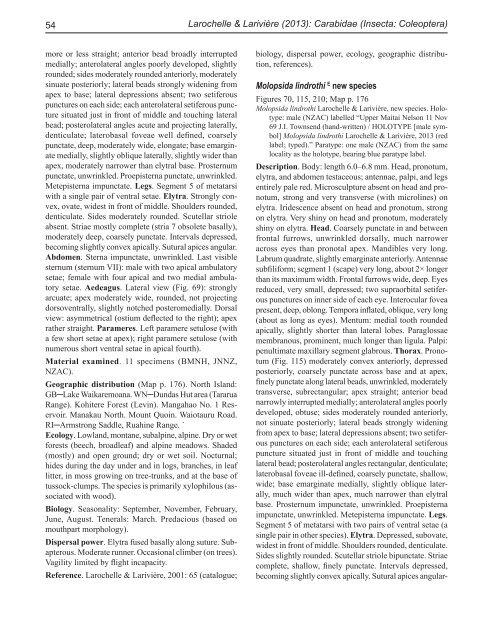Fauna of New Zealand 69 - Landcare Research
Fauna of New Zealand 69 - Landcare Research
Fauna of New Zealand 69 - Landcare Research
Create successful ePaper yourself
Turn your PDF publications into a flip-book with our unique Google optimized e-Paper software.
54<br />
more or less straight; anterior bead broadly interrupted<br />
medially; anterolateral angles poorly developed, slightly<br />
rounded; sides moderately rounded anteriorly, moderately<br />
sinuate posteriorly; lateral beads strongly widening from<br />
apex to base; lateral depressions absent; two setiferous<br />
punctures on each side; each anterolateral setiferous puncture<br />
situated just in front <strong>of</strong> middle and touching lateral<br />
bead; posterolateral angles acute and projecting laterally,<br />
denticulate; laterobasal foveae well defined, coarsely<br />
punctate, deep, moderately wide, elongate; base emarginate<br />
medially, slightly oblique laterally, slightly wider than<br />
apex, moderately narrower than elytral base. Prosternum<br />
punctate, unwrinkled. Proepisterna punctate, unwrinkled.<br />
Metepisterna impunctate. Legs. Segment 5 <strong>of</strong> metatarsi<br />
with a single pair <strong>of</strong> ventral setae. Elytra. Strongly convex,<br />
ovate, widest in front <strong>of</strong> middle. Shoulders rounded,<br />
denticulate. Sides moderately rounded. Scutellar striole<br />
absent. Striae mostly complete (stria 7 obsolete basally),<br />
moderately deep, coarsely punctate. Intervals depressed,<br />
becoming slightly convex apically. Sutural apices angular.<br />
Abdomen. Sterna impunctate, unwrinkled. Last visible<br />
sternum (sternum VII): male with two apical ambulatory<br />
setae; female with four apical and two medial ambulatory<br />
setae. Aedeagus. Lateral view (Fig. <strong>69</strong>): strongly<br />
arcuate; apex moderately wide, rounded, not projecting<br />
dorsoventrally, slightly notched posteromedially. Dorsal<br />
view: asymmetrical (ostium deflected to the right); apex<br />
rather straight. Parameres. Left paramere setulose (with<br />
a few short setae at apex); right paramere setulose (with<br />
numerous short ventral setae in apical fourth).<br />
Material examined. 11 specimens (BMNH, JNNZ,<br />
NZAC).<br />
Geographic distribution (Map p. 176). North Island:<br />
GB─Lake Waikaremoana. WN─Dundas Hut area (Tararua<br />
Range). Kohitere Forest (Levin). Mangahao No. 1 Reservoir.<br />
Manakau North. Mount Quoin. Waiotauru Road.<br />
RI─Armstrong Saddle, Ruahine Range. `<br />
Ecology. Lowland, montane, subalpine, alpine. Dry or wet<br />
forests (beech, broadleaf) and alpine meadows. Shaded<br />
(mostly) and open ground; dry or wet soil. Nocturnal;<br />
hides during the day under and in logs, branches, in leaf<br />
litter, in moss growing on tree-trunks, and at the base <strong>of</strong><br />
tussock-clumps. The species is primarily xylophilous (associated<br />
with wood).<br />
Biology. Seasonality: September, November, February,<br />
June, August. Tenerals: March. Predacious (based on<br />
mouthpart morphology).<br />
Dispersal power. Elytra fused basally along suture. Subapterous.<br />
Moderate runner. Occasional climber (on trees).<br />
Vagility limited by flight incapacity.<br />
Reference. Larochelle & Larivière, 2001: 65 (catalogue;<br />
Larochelle & Larivière (2013): Carabidae (Insecta: Coleoptera)<br />
biology, dispersal power, ecology, geographic distribution,<br />
references).<br />
Molopsida lindrothi E new species<br />
Figures 70, 115, 210; Map p. 176<br />
Molopsida lindrothi Larochelle & Larivière, new species. Holotype:<br />
male (NZAC) labelled “Upper Maitai Nelson 11 Nov<br />
<strong>69</strong> J.I. Townsend (hand-written) / HOLOTYPE [male symbol]<br />
Molopsida lindrothi Larochelle & Larivière, 2013 (red<br />
label; typed).” Paratype: one male (NZAC) from the same<br />
locality as the holotype, bearing blue paratype label.<br />
Description. Body: length 6.0–6.8 mm. Head, pronotum,<br />
elytra, and abdomen testaceous; antennae, palpi, and legs<br />
entirely pale red. Microsculpture absent on head and pronotum,<br />
strong and very transverse (with microlines) on<br />
elytra. Iridescence absent on head and pronotum, strong<br />
on elytra. Very shiny on head and pronotum, moderately<br />
shiny on elytra. Head. Coarsely punctate in and between<br />
frontal furrows, unwrinkled dorsally, much narrower<br />
across eyes than pronotal apex. Mandibles very long.<br />
Labrum quadrate, slightly emarginate anteriorly. Antennae<br />
subfiliform; segment 1 (scape) very long, about 2× longer<br />
than its maximum width. Frontal furrows wide, deep. Eyes<br />
reduced, very small, depressed; two supraorbital setiferous<br />
punctures on inner side <strong>of</strong> each eye. Interocular fovea<br />
present, deep, oblong. Tempora inflated, oblique, very long<br />
(about as long as eyes). Mentum: medial tooth rounded<br />
apically, slightly shorter than lateral lobes. Paraglossae<br />
membranous, prominent, much longer than ligula. Palpi:<br />
penultimate maxillary segment glabrous. Thorax. Pronotum<br />
(Fig. 115) moderately convex anteriorly, depressed<br />
posteriorly, coarsely punctate across base and at apex,<br />
finely punctate along lateral beads, unwrinkled, moderately<br />
transverse, subrectangular; apex straight; anterior bead<br />
narrowly interrupted medially; anterolateral angles poorly<br />
developed, obtuse; sides moderately rounded anteriorly,<br />
not sinuate posteriorly; lateral beads strongly widening<br />
from apex to base; lateral depressions absent; two setiferous<br />
punctures on each side; each anterolateral setiferous<br />
puncture situated just in front <strong>of</strong> middle and touching<br />
lateral bead; posterolateral angles rectangular, denticulate;<br />
laterobasal foveae ill-defined, coarsely punctate, shallow,<br />
wide; base emarginate medially, slightly oblique laterally,<br />
much wider than apex, much narrower than elytral<br />
base. Prosternum impunctate, unwrinkled. Proepisterna<br />
impunctate, unwrinkled. Metepisterna impunctate. Legs.<br />
Segment 5 <strong>of</strong> metatarsi with two pairs <strong>of</strong> ventral setae (a<br />
single pair in other species). Elytra. Depressed, subovate,<br />
widest in front <strong>of</strong> middle. Shoulders rounded, denticulate.<br />
Sides slightly rounded. Scutellar striole bipunctate. Striae<br />
complete, shallow, finely punctate. Intervals depressed,<br />
becoming slightly convex apically. Sutural apices angular-
















